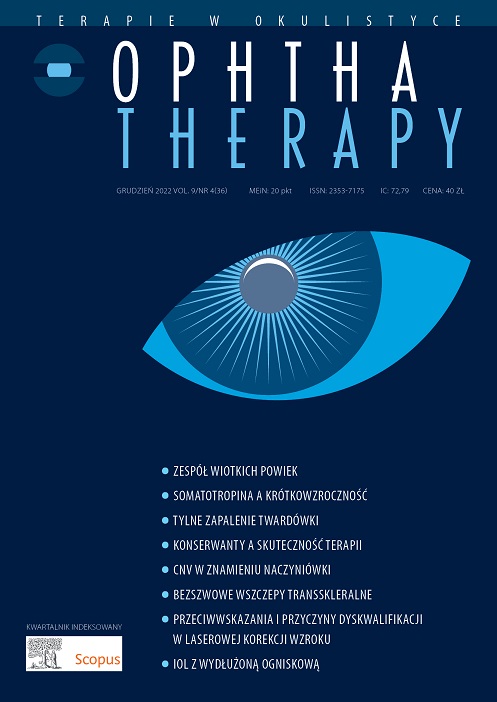Do preservatives enhance corneal permeability and thus the effectiveness of ophthalmic drugs? Review article
Main Article Content
Abstract
Preservatives used in ophthalmic preparations are chemical compounds with an antibactericidal effect. They ensure the sterility of the drug, preventing accidental contamination with microorganisms and the development of microorganisms in the bottle, which may cause infection of the eye tissues, and additionally change the physicochemical properties of the active substance. The most commonly used preservative in ophthalmology is benzalkonium chloride which, by acting as a surfactant, unseals the connections between corneal epithelial cells, facilitating the penetration of the drug. Studies in rabbits using benzalkonium chloride have shown a significant increase in corneal penetration. Studies comparing the same effectiveness of drugs without preservatives in relation to drugs with preservatives have been carried out many times, showing similar effects of preparations in most studies. Some studies, however, describe a better effect of preserved drugs, which will be presented in the article.
Downloads
Article Details

This work is licensed under a Creative Commons Attribution-NonCommercial-NoDerivatives 4.0 International License.
Copyright: © Medical Education sp. z o.o. License allowing third parties to copy and redistribute the material in any medium or format and to remix, transform, and build upon the material, provided the original work is properly cited and states its license.
Address reprint requests to: Medical Education, Marcin Kuźma (marcin.kuzma@mededu.pl)
References
2. Wpływ środków konserwujących na tkanki oka. In: Prost M (ed). Kliniczna farmakologia okulistyczna. Elsevier Urban & Partner, Wrocław 2013.
3. Freeman PD, Kahook MY. Preservatives in topical ophthalmic medications: historical and clinical perspectives. Expert Rev Ophthalmol. 2009; 4: 59-64.
4. EMEA public statement on antimicrobial preservatives in ophthalmic preparations for human use (EMEA/622721/2009).
5. Baudouin C, Labbé A, Liang H et al. Preservatives in eyedrops: the good, the bad and the ugly. Prog Retin Eye Res. 2010; 29: 312-34.
6. Majumdar S, Hippalgaonkar K, Repka MA. Effect of chitosan, benzalkonium chloride and ethylenediaminetetraacetic acid on permeation of acyclovir across isolated rabbit cornea. Int J Pharm. 2008; 348: 175-8.
7. Rupankar S. Effects of preservatives used in ocular medications on the eye: a comparative review. Ophthalmol J. 2021; 6: 44-52. http://doi.org/10.5603/OJ.2021.0009.
8. Wirta D, Malhotra R, Peace J et al. Noninferiority Study Comparing Latanoprost 0.005% Without Versus With Benzalkonium Chloride in Open-Angle Glaucoma or Ocular Hypertension. Eye Contact Lens. 2022; 48(4): 149-54. http://doi.org/10.1097/ICL.0000000000000860.
9. Shen Lee B, Malhotra R, Sall K et al. Open-Label Extension Study Comparing Latanoprost 0.005% Without vs With Benzalkonium Chloride in Open-Angle Glaucoma or Ocular Hypertension. Clin Ophthalmol. 2022; 16: 2285-93. http://doi.org/ 10.2147/OPTH.S367756.
10. Skov AG, Rives AS, Freiberg J et al. Comparative efficacy and safety of preserved versus preservative-free beta-blockers in patients with glaucoma or ocular hypertension: a systematic review. Acta Ophthalmol. 2022; 100(3): 253-61. http://doi.org/10.1111/aos.14926.
11. European Glaucoma Society Terminology and Guidelines for Glaucoma, 5th ed. Br J Ophthalmol. 2021; 105(Suppl 1): 1-169. http://doi.org/10.1136/bjophthalmol-2021-egsguidelines.
12. Moiseev RV, Morrison PWJ, Steele F et al. Penetration Enhancers in Ocular Drug Delivery. Pharmaceutics. 2019; 11(7): 321. http://doi.org/10.3390/pharmaceutics11070321.
13. Jarvinen T, Jarvinen K. Prodrugs for improved ocular drug delivery. Adv Drug Deliv Rev. 1996; 19(2): 203-24.

